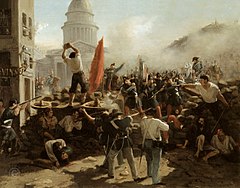1. The year 1848 marked a very Revolutionary period that effected almost every corner of Europe. All across Europe, revolts and revolutions popped up, many of them having similar goals and grievances. In Italy, specifically Sicily, revolutionists wanted to see Italy out of Bourbon rule. In their place, they proposed an Italian confederation of the different states. In France, anarchists fought against the monarchy in the "February Revolution". Some Germans wanted to see a unification of their uni-lingual states for both political and economic reasons. More liberal 'anarchists' in Denmark and Belgium also sought the dissolution of their monarchies. The Polish fought against their Prussian rulers. Constituents of the Hapsburg Empire with nationalist goals sought independence from their overlord.
2. The July Monarchy (1830-1848) was a liberal response to the conservative efforts of Charles X, who claimed monarchy over the French. The Bourgeoisie and Napoleonic officials in France overthrew the king and set up a loose collection of conservative policies under the rule of François Guizot. However, by 1848, his attempts to liberalise France through monarchical power, his empiric rule, and even perhaps his desire to begin ties with Britain, Guizot's July Monarchy was quickly crushed.
3. The French Revolution was the first of many revolutions like it that took place all across Central Europe by 1848. Once the French Revolution had taken place, revolutions with similar goals sprang up all over Europe. These revolutions were often middle to lower classmen seeking to rise against their monarchies in hope to attain better civil and political rights as well as financial stability.
4. The Revolutions in the German, Hapsburg, and Italian states all were similar in their collaborative efforts. These states, soon to become unified nations, were all independent from each other. Avoiding the empirical trends of western Europe, these uni-lingual states remained as fractured pieces of similar cultures and histories. In the German states, liberal intellectuals across the states demanded for the state governments to cease their multitudinous and heavy taxation as well as their censorship and blockade on free speech. The Hapsburg revolutionaries were similarly also motivated by political and social rights, also had nationalistic goals. The constituents of the Hapsburg Empire had diverse cultures and languages, which pushed for independence from the Empire and with their similar cultures. Italy for centuries was ravished by foreign occupation and interstate warfare. Revolutionaries in Italy revolted against their Bourbon occupants and the economic and social rights they lacked under their rule.
5. The radical liberalism that was permitted during the French Revolution and the Napoleonic period was well enjoyed by Frenchmen. The government, for once, was at the democratic manipulation of the French. However, the July Monarchy and Revolution of 1848 was a radical whiplash in a monarchical direction. Conservatives made strict and powerful motions to "deliberalise" France, an action that Merriman terms as the "agony of the Republic of France".
6. Britain did experience some political unrest in the year 1848, but to no extent close to those in continental Europe at that time. The Chartist movement in England merely put pressure on the British government during this time, non-violent demonstrations sought to improve the British government through social reform, rather than replacing it. Britain, in terms of political progression, was a step ahead of the continent. Many of the issues that were being brought up in the continental revolutions were solved in Britain by reforms and bills written earlier in that century if not settled in the revolutions within their past two centuries.

No comments:
Post a Comment